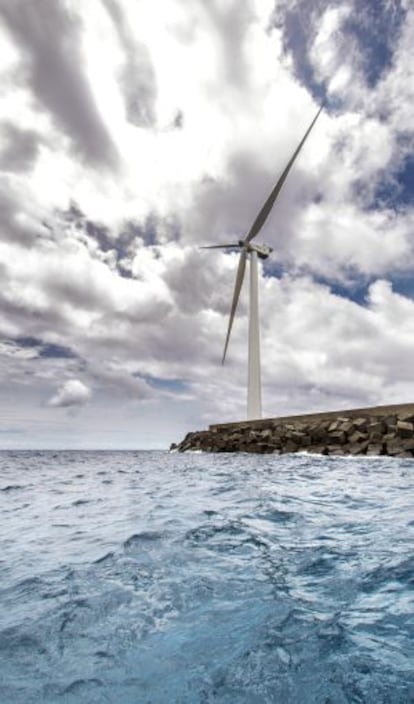From the Canaries to the North Sea
Spain’s Gamesa is hoping to carve out a place in the growing offshore electricity sector Its turbine in Gran Canaria can power 7,500 homes

Spain's first offshore wind turbine, launched in October, dominates the skyline in the port of Arinaga on Gran Canaria. The five-megawatt turbine - which stands 154 meters tall, with 62.5-meter long blades - produces enough electricity to supply 7,500 homes in the Canary Islands, although this is not its main purpose. The G-128 is a 200-million-euro prototype developed by Spanish company Gamesa, which it hopes will win it a place in the growing offshore wind-turbine market, particularly in the North Sea.
"The site selected boasts optimal conditions for the installation, validation and certification of the prototype: the region has high wind resources [strong trade winds] combined with availability of wind data from meteorological towers," says Gamesa's executive president, Ignacio Martín.
So far, offshore wind turbines produce just 1.9 percent of all wind-generated electricity globally, but they are seen by many governments around the world as the best renewable option. Installing and maintaining offshore wind turbines is a complicated and expensive business - Gamesa says the cost of producing a megawatt of electricity offshore is up to three times that of a land-based turbine.
Gamesa's approach is to make its offshore wind turbines as independent as possible to reduce maintenance costs. Using the technology it has developed for its 4.5-megawatt land turbines, it has incorporated monitoring systems that can be run from land.
The advantage of offshore turbines, despite the technical difficulties of installing and maintaining them, is that sea winds are more powerful and more predictable than those over land, which are affected by topography. The European Commission wants to see some 150 gigawatts of offshore wind-produced energy in use by 2030, some 14 percent of EU demand, to meet its environmental objectives. The European Environmental Agency goes further, and says that by the same date it will be possible for almost 80 percent of demand in the European Union to be met by wind turbines.
Gamesa's priority in the offshore market is to achieve product certification in order to guarantee the successful launch, marketing and manufacturing of its offshore platforms in the years ahead. The company is waiting for certification that will allow it to begin selling its turbines. Within the EU, the biggest market is among countries bordering the North Sea. The United Kingdom (in particular Scotland) and Germany, which have already invested significantly in wind power, offer the most promise. The UK plans to install hundreds of wind turbines in the North Sea to raise its offshore generating capacity.
Sea winds are more powerful and more predictable than those over land
The company is also looking at the Chinese market, which is still in its infancy. Brazil offers huge potential, and in fact Gamesa already has a 22-percent market share there.
"Based on the current situation, the US market appears to be set to develop later than others. Regional and country-specific market conditions warrant even more rational decision-making processes than ever, from both the technology and financial standpoints," says Jorge Calvet, the former chairman and CEO of Gamesa.
The turbine "highlights the government's entire energy policy," Industry Minister Jose Manuel Soria said at the official opening. "In the first half of the year, more than half of all the electricity produced in Spain came from renewable sources," he said. Spain has pioneered the development of wind turbines, and is ranked number four in the world in terms of the installed capacity of its wind energy.
The sector, which has long enjoyed state subsidies, has suffered a plunge in support in recent years as Spain implements austerity policies to drive down its annual budget shortfalls, forcing Gamesa to look abroad for new markets.
The outlook for the Spanish market is bleak. As a result, "100 percent" of new wind turbines are now installed outside of Spain, says Ignacio Martín. Though Spain has 8,000 kilometers of coastline, it is unlikely to boast wind turbines in the near future because the surrounding seas are too deep.
The prototype operating in the Canary Islands was built entirely in Spain, at three different sites, but if Gamesa finds new markets for its wind turbines, it will have to build them closer to where they are going to be used.
Gamesa is making progress on the installation of its offshore manufacturing base. To this end, it recently announced it had entered talks with the Forth Ports at Leith, in Scotland to set up its offshore manufacturing base in the UK, which will comprise the installation of nacelle- and blade-manufacturing plants, as well as port logistics and operations and maintenance service platforms.
Depending on how the market develops, this new manufacturing base could generate around 800 new jobs in the UK, says Martín. Over the coming years, and depending on the sales opportunities, Gamesa's UK program could entail investment of roughly 150 million euros.
Tu suscripción se está usando en otro dispositivo
¿Quieres añadir otro usuario a tu suscripción?
Si continúas leyendo en este dispositivo, no se podrá leer en el otro.
FlechaTu suscripción se está usando en otro dispositivo y solo puedes acceder a EL PAÍS desde un dispositivo a la vez.
Si quieres compartir tu cuenta, cambia tu suscripción a la modalidad Premium, así podrás añadir otro usuario. Cada uno accederá con su propia cuenta de email, lo que os permitirá personalizar vuestra experiencia en EL PAÍS.
¿Tienes una suscripción de empresa? Accede aquí para contratar más cuentas.
En el caso de no saber quién está usando tu cuenta, te recomendamos cambiar tu contraseña aquí.
Si decides continuar compartiendo tu cuenta, este mensaje se mostrará en tu dispositivo y en el de la otra persona que está usando tu cuenta de forma indefinida, afectando a tu experiencia de lectura. Puedes consultar aquí los términos y condiciones de la suscripción digital.








































